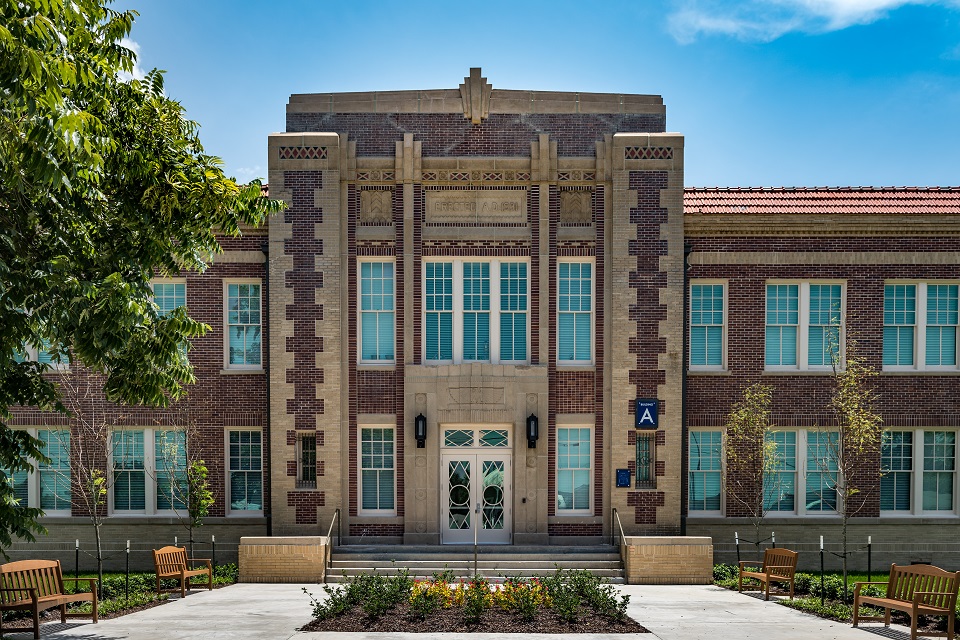News Release

Michael Palumbo Photography
News Release Date: October 15, 2018
Contact: NewsMedia@nps.gov
Federal Historic Preservation Tax Incentives Program Celebrates its 40th Year
WASHINGTON – According to the Rutgers University’s Center for Urban Policy Research, the Federal Historic Preservation Tax Incentives Program contributed more than $12.2 billion in output in terms of goods and services to the U.S. economy and added $6.2 billion in gross domestic product in Fiscal Year 2017. The program is administered by the National Park Service and the Internal Revenue Service, in partnership with State Historic Preservation Offices.
"Historic preservation tax incentives continue to drive investments in historic preservation and revitalize communities across the country," said National Park Service Deputy Director P. Daniel Smith. "Over the past 40 years, this successful federal/state partnership has enabled the preservation and rehabilitation of more than 43,000 historic properties, while generating more than $144 billion in private investment along the way."
The Federal Historic Preservation Tax Incentives Program, commonly known as the Federal Historic Tax Credit program, provides a 20 percent federal tax credit to property owners who undertake a substantial rehabilitation of a historic building in a commercial or other income producing use, while maintaining its historic character.
The National Park Service certifies a building is historic, and therefore eligible for the program, and that the rehabilitation preserves the building’s historic character.The tax incentives program has helped to revive abandoned or underutilized schools, warehouses, factories, churches, retail stores, apartments, hotels, houses, agricultural buildings, offices, and other buildings across the country, and in turn, has helped support the redevelopment of entire downtowns and neighborhoods. It also supports community revitalization, job creation, affordable housing, small businesses, farms and Main Street development, among other economic benefits.
According to the report, 50 percent of the certified rehabilitation projects were located in low and moderate income areas and more than 79 percent were located in economically distressed areas. Half of all projects were less than $1 million and 20 percent were less than $250,000. A quarter of all certified rehabilitation projects were located in communities with a population of less than 50,000 people and more than 15 percent in communities with a population less than 25,000 people.
In Fiscal Year 2017, program-related investments created approximately 107,000 jobs, including 38,000 in construction and 24,000 in manufacturing, generating $2.0 billion and $1.8 billion respectively. As a result of both direct and multiplier effects, and due to the interconnectedness of the national economy, sectors not immediately associated with historic rehabilitation, such as agriculture, mining, transportation, and public utilities, benefited as well.
State Historic Preservation Offices are the first point of contact for information and guidance for property owners interested in the program, and the National Park Service works closely with them in the administration of the program. A breakdown by state of the economic impacts and other program information is included in the reports.
Fiscal Year 2017 Highlights and Reports
- Federal Tax Incentives for Rehabilitating Historic Buildings Annual Report for Fiscal Year 2017
- Annual Report on the Economic Impact of the Federal Historic Tax Credit for Fiscal Year 2017
Case Studies
- Zeigler’s Drug Store/Allen’s Hall (Florence, South Carolina): According to the project’s developer, the cost of renovating the historic Zeigler’s Drug Store, in comparison with the local rental market, would have been too risky. The tax credit equity was critical to the financing of the project.
- Equitable Life Insurance Company of Iowa (Des Moines, Iowa): The rehabilitation of the Equitable Building has had a noticeable economic impact on downtown Des Moines. The use of historic tax credits allowed the developer to transform a building, underutilized or vacant for almost a decade, into a vibrant place for hundreds of people to reside and work.
- Owyhee Hotel (Boise, Idaho): Located in the west end of downtown, the hotel was in an area that had experienced little new investment in recent decades and was surrounded by many underutilized and undeveloped properties. The rehabilitation of the Owyhee, however, has enlivened this area and spurred significant new investment by neighboring property owners.
- Houma Elementary School (Houma, Louisiana): The development of Academy Place Apartments has been a boon to the community which was severely lacking in available senior housing. The project has returned a vacant building once again to active use - this time as mixed-income senior housing.
Fiscal Year 2017
Rehabilitated Housing Units
Rehabilitated new or existing housing units: 19,198
Low - and moderate-income housing units: 6,803
Economic Benefit
Total estimated rehabilitation investment (Qualified Rehabilitation Expenditures): $5.8 billion
Historic rehabilitation projects certified: 1,035
Estimated total jobs create: 106,846
Output (Goods and Services): $12.2 billion
Gross domestic product: $6.2 billion
Income created: $4.6 billion
40 Year Anniversary Highlights
Rehabilitated Housing Units
Rehabilitated housing units: 278,270
New housing units: 289,933
Low - and moderate-income housing units: 160,058
Economic Benefit*
Estimated rehabilitation investment: $89.97 billion
Historic rehabilitation projects certified: 43,328
Estimated rehabilitation investment: $144.6 billion
Estimated total jobs create: 2.5 million
Gross domestic product: $158 billion
Income created: $116 billion
*Adjusted for inflation to 2017 dollars. Numbers reflect economic impacts beginning with the certification of the program’s first project in the 1977-1978 fiscal year.
About the National Park Service. More than 20,000 National Park Service employees care for America's 417 national parks and work with communities across the nation to help preserve local history and create close-to-home recreational opportunities. Visit us at www.nps.gov, on Facebook www.facebook.com/nationalparkservice, Twitterwww.twitter.com/natlparkservice, and YouTube www.youtube.com/nationalparkservice.
Last updated: October 15, 2018
